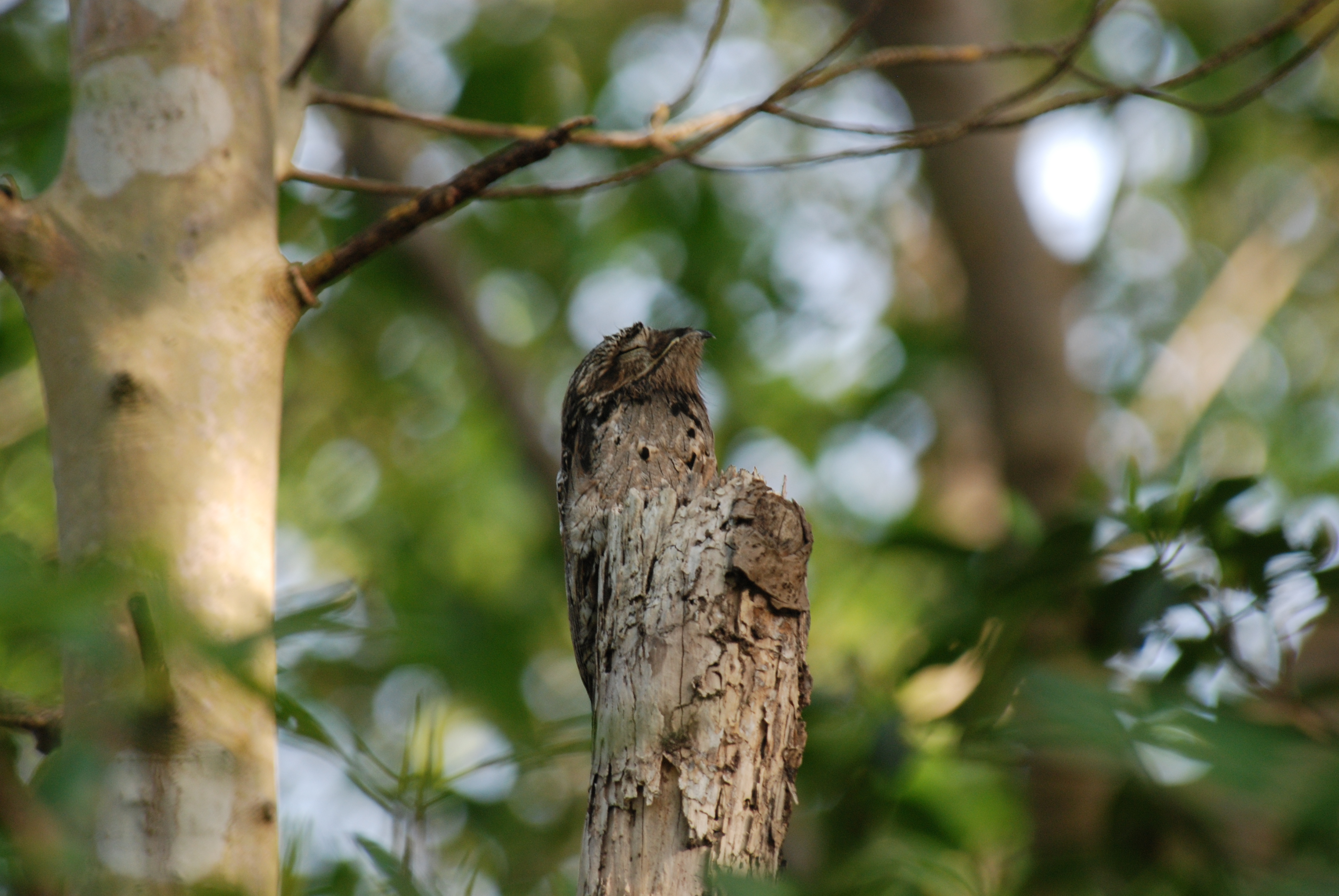- Lesser Potoo
Taxobox
name = Lesser Potoo
status = LC
status_system = iucn3.1
image_width = 220px

image_caption = Well-camouflaged on a broken branch.
regnum =Animalia
phylum =Chordata
classis =Aves
subclassis =Neornithes
infraclassis =Neognathae
unranked_ordo =Cypselomorphae
ordo =Caprimulgiformes
familia =Nyctibiidae
genus = "Nyctibius "
species = "N. griseus"
binomial = "Nyctibius griseus"
binomial_authority = (Gmelin,1789 )The Lesser Potoo or Common Potoo ("Nyctibius griseus"), is a nocturnal
bird which breeds in tropical Central andSouth America fromCosta Rica to northernArgentina and northernUruguay . TheNorthern Potoo ("N. jamaicensis") was formerly classified as asubspecies of this species.This
potoo is a largenear passerine bird related to thenightjar s andfrogmouth s, but like other potoos it lacks the bristles around the mouth found in the true nightjars. It is 33-38cm long and pale greyish to brown, finely patterned with black and buff,camouflage d to look like a log; this is a safety measure to help protect it from predators, but its "mode of perch" is also a camouflage. It has large orange eyes.The Lesser Potoo can be located at night by the reflection of light from its eyes as it sits on a post, or by its haunting melancholic song, a "BO-OU, BO-ou, bo-ou, bo-ou, bo-ou, bo-ou, bo-ou, bo-ou" dropping in both pitch and volume.
It is a resident breeder in open woodlands and savannah. It avoids cooler montane regions, rarely occurring over 1,900 meters ASL even in the hottest parts of its range [Cuervo "et al." (2003)] . Also,
arid regions are usually avoided; for example in the dryCaribbean plain ofColombia the species was first recorded in April 1999 [Strewe & Navarro (2004)] .This nocturnal
insectivore hunts from a perch like ashrike orflycatcher . During the day it perches upright on a tree stump, and is completely invisible, looking like part of the stump because it stays so completely still as it perches.The singleFact|date=March 2008 egg is white with lilac spotsFact|date=March 2008. It laid directly in a depression in a tree limb [E.g. of "
Cecropia ": Greeney "et al." (2004)] , usually some meters above ground. It is not clear whether there can be, on occasion, two eggs in a clutch. [Greeney "et al." (2004)]Footnotes
References
*|year=2004|id=48628|title=Nyctibius griseus|downloaded=11 May 2006 Database entry includes justification for why this species is of least concern
* (2003): New and noteworthy bird records from the northern sector of the Western Andes of Colombia. "Bull. B. O. C." 123(1): 7-24. [http://www.zoo.ufl.edu/gustavo/images/pdf/Cuervo_etal2003BBOC.pdf PDF fulltext]
* (1991): "A guide to the birds of Trinidad and Tobago" (2nd edition). Comstock Publishing, Ithaca, N.Y.. ISBN 0-8014-9792-2
* (2004): Notes on breeding birds from an Ecuadorian lowland forest. "Bull. B.O.C." 124(1): 28-37. [http://depts.washington.edu/nhrg/Greeney,%20Gelis%20%26%20White%202004.pdf PDF fulltext]
* (2003): "Birds of Venezuela". Christopher Helm, London. ISBN 0-7136-6418-5
* (2004): New and noteworthy records of birds from the Sierra Nevada de Santa Marta region, north-eastern Colombia. "Bull. B.O.C." 124(1): 38-51. [http://www.alpec.org/Articulo%20BBOC/Strewe%20&%20Navarro%202004%20BBOC%20124%20(1).pdf PDF fulltext]External links
* [http://ibc.hbw.com/ibc/phtml/especie.phtml?idEspecie=2775 "Common Potoo" videos] on the Internet Bird Collection
* [http://vireo.acnatsci.org/search.html?Form=Search&SEARCHBY=Common&KEYWORDS=common+potoo&showwhat=images&AGE=All&SEX=All&ACT=All&Search=Search&VIEW=All&ORIENTATION=All&RESULTS=24 "Common Potoo" photo gallery] VIREO
Wikimedia Foundation. 2010.
